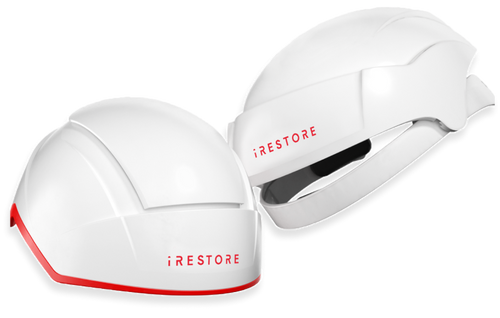
Is your hair acting out? Suddenly feeling drier or more brittle than you remember? Thinner or less manageable?
Have you looked at yourself in the mirror and wondered, “What is going on?”
You’re not alone.
Many women over 40 are experiencing similar changes—in a BIG way.
Changes come in waves, some slow and subtle and others make you feel like you’re a different person overnight. Let’s start at the top with the mane attraction––your hair. What was once thick and lustrous may have started to become dull and grey. And even if you always had thinner hair, it’s hard to ignore there’s even less there to gripe about.
So what’s going on? And more importantly, what can you do about it?
Here are a few tips that will take the stress out of dealing with your mature tresses:
1. Dull, Dry & Brittle Hair
Most women experience a change in the texture and appearance of their hair as they age. We’re not just talking about the pesky grays (more on that later), but the unmistakable coarse and brittle nature that serves as an unrelenting reminder that mother nature is turning the hands of time.
What’s going on:
One word – hormones.
Yes, they’re back again.
Actually, it’s what’s missing that’s at play here. Estrogen levels steadily decline as women reach their forties and head towards menopause (oh no!). As a result, testosterone levels––the same sex hormone in men––start to dominate. Now, testosterone isn’t all bad (it actually can help women live longer), but it does come with a price and that often means drying, dulling, thinning hair.
What you can do about it:
First and foremost, put the styling products down. That’s right, while your instinct is to style your way out of lackluster hair, you are in fact adding to the problem. Sorry, but your styling products are most likely further drying or damaging your hair. Don’t worry! You actually have an ACE up your sleeve that can help...
Okay, not literally, but take a peek into your medicine cabinet or refrigerator, we’re talking about Vitamins A, C, and E all of which help promote cell and tissue growth. Add to that a healthy diet of foods rich in calcium, antioxidants and Omega-3 fatty acids and you have a recipe for success.
You can, in fact, eat your way to more luscious locks, which will reduce your risk of overstyling and further damaging your hair. And don’t forget the obvious counter punch to dry, brittle hair—stay hydrated!
2. Gray Hair
Probably the most common issue all women (and men) over 40 face is the appearance of gray hairs. It’s become the universal symbol for aging even though it’s not always the case (you can actually start seeing gray hairs as early as your late teens). To be fair, premature graying is most often rooted in genetics. Individuals that witness gray hairs popping up in their late teens or early twenties are likely lacking the melanin production needed to give hair its color.
What’s going on:
The first thing to note is that your hair isn’t turning gray…it’s GROWING in gray.
As mentioned earlier, the color of your hair is rooted in the production of melanin, which gives your hair (and your skin) its color. As you age, your melanin production slows down and eventually as your hair grows and finally sheds, the new hair grows in gray. It’s not surprising then, that individuals with red or lighter hair tend to show grays sooner than their darker hair counterparts.
Aside from mother nature, there are other potential culprits that pepper some salt in our hair—a lack of Vitamin B12, B7 (more commonly known as biotin) and Vitamin D. Low levels of B12 affect the production of melanin, and as we age our body has a harder time absorbing B12. In more serious cases, low levels of B12 is attributed to pernicious anemia and one of the symptoms of that includes gray hair.
Low Vitamin D levels lead to a host of problems from auto-immune issues, to low bone density to grey hair. However, there is a silver lining when it comes to Vitamin D. Increasing your vitamin D intake can actually help restore the growth of your pigmented hair and seemingly ‘reverse’ grays.
What you can do about it:
Let’s start at the root of the matter. You can’t run away from gray hair, none of us can.
But you can slow it down and in some cases reduce the appearance of grays by growing healthier, pigmented hair (some researchers have actually suggested that low-level laser therapy can restore your hair and reduce graying).
The most common response is to dye your hair. This is certainly effective but requires regular maintenance to keep up appearances.
Our advice is to be very conscious of the types of products your hairstylist uses because harsh chemicals and too much hydrogen peroxide actually contributes to bleaching out your hair more in the long run, not to mention the drying and thinning effects.
If you haven’t had your Vitamin B12 and D levels checked recently, it would be worth paying your doctor a visit and having them order some blood work. If it turns out that you’re lacking in those areas you can easily boost your levels with supplements, diet, and even just some good ol’ sun.
That’s right, if Vitamin D turns out to be the culprit, letting your hair/scalp get some sun helps to stimulate melanin production.
At the end of the day, don’t forget: “Gray hair is a blessing, just ask any bald man!”
3. Thinning Hair
One of the more alarming changes women experience is female pattern baldness or thinning hair. All women can expect to experience some level of hair loss. According to Prevention:
50% of women will experience some form of hair loss by age 50.
For some, the hair loss is minor and for others it can be pretty drastic, even revealing parts of the scalp through the hair.
What’s going on:
Hair growth rate naturally slows down with age, that’s to be expected. More significant hair loss is attributed to changes in hormone levels, especially as women approach and reach menopause. An underactive thyroid is often another major cause. In essence, it’s not so much that you’re losing hair, you’re just not growing more hair than you’re shedding.
What you can do about it:
If you’re not certain what’s causing your thinning hair, consult your doctor, ideally, an endocrinologist since hormones and thyroid function are their specialties. Identifying the cause could help you press pause and slow down the fall out rate.
If there’s no significant underlying cause for your hair loss, you might find relief in FDA-cleared solutions designed to restore thicker and fuller hair growth – like the iRESTORE Laser Hair Growth System.
CONCLUSION
At the end of the day, no matter what issues you face with your hair, there are steps you can take steps to minimize its impact on your life and appearance. For some, the challenge is greater than others. No matter what the end result is, the most important thing to remember is – don’t stress over it too much.
Gray and thinning hair is a part of aging and a natural part of life. We’re all for taking advantage of the (safe) solutions out there to reverse the effects and improve your appearance, but sometimes it’s more important to simply embrace it and enjoy your life.
After all, stress never made anyone look or feel younger!
P.S. If you’d like to start taking care of your hair more and don’t know where to start, check out our drug-free and non-invasive solutions, which includes some of our favorites: the Thickening Shampoo and the Hair Growth Formula.















